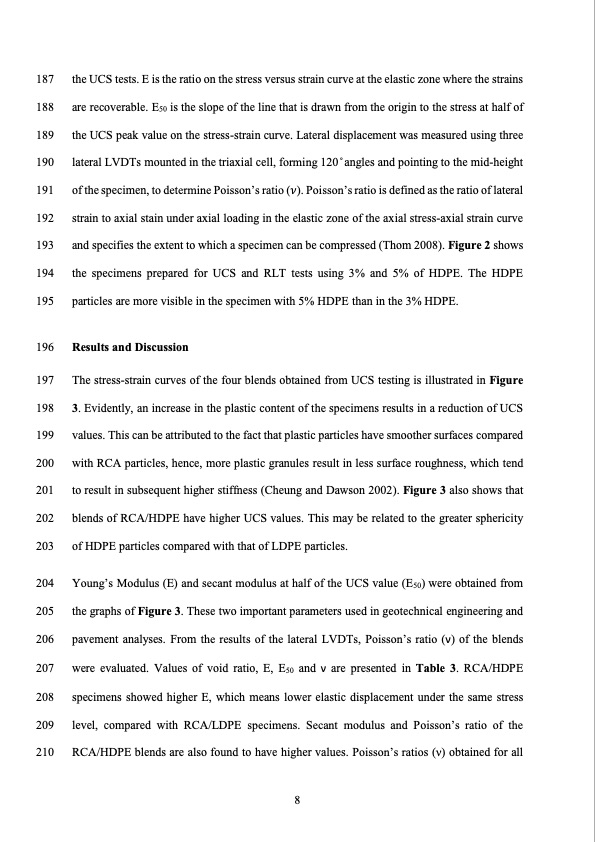
PDF Publication Title:
Text from PDF Page: 009
187 the UCS tests. E is the ratio on the stress versus strain curve at the elastic zone where the strains 188 are recoverable. E50 is the slope of the line that is drawn from the origin to the stress at half of 189 the UCS peak value on the stress-strain curve. Lateral displacement was measured using three 190 lateral LVDTs mounted in the triaxial cell, forming 120 ̊ angles and pointing to the mid-height 191 of the specimen, to determine Poisson’s ratio (𝜈). Poisson’s ratio is defined as the ratio of lateral 192 strain to axial stain under axial loading in the elastic zone of the axial stress-axial strain curve 193 and specifies the extent to which a specimen can be compressed (Thom 2008). Figure 2 shows 194 the specimens prepared for UCS and RLT tests using 3% and 5% of HDPE. The HDPE 195 particles are more visible in the specimen with 5% HDPE than in the 3% HDPE. 196 Results and Discussion 197 The stress-strain curves of the four blends obtained from UCS testing is illustrated in Figure 198 3. Evidently, an increase in the plastic content of the specimens results in a reduction of UCS 199 values. This can be attributed to the fact that plastic particles have smoother surfaces compared 200 with RCA particles, hence, more plastic granules result in less surface roughness, which tend 201 to result in subsequent higher stiffness (Cheung and Dawson 2002). Figure 3 also shows that 202 blends of RCA/HDPE have higher UCS values. This may be related to the greater sphericity 203 of HDPE particles compared with that of LDPE particles. 204 Young’s Modulus (E) and secant modulus at half of the UCS value (E50) were obtained from 205 the graphs of Figure 3. These two important parameters used in geotechnical engineering and 206 pavement analyses. From the results of the lateral LVDTs, Poisson’s ratio (ν) of the blends 207 were evaluated. Values of void ratio, E, E50 and ν are presented in Table 3. RCA/HDPE 208 specimens showed higher E, which means lower elastic displacement under the same stress 209 level, compared with RCA/LDPE specimens. Secant modulus and Poisson’s ratio of the 210 RCA/HDPE blends are also found to have higher values. Poisson’s ratios (ν) obtained for all 8PDF Image | Stiffness Properties of Recycled Concrete Aggregate with Polyethylene Plastic Granules

PDF Search Title:
Stiffness Properties of Recycled Concrete Aggregate with Polyethylene Plastic GranulesOriginal File Name Searched:
Ep38221_Stiffness-Properties.pdfDIY PDF Search: Google It | Yahoo | Bing
Development of a solar powered Electric Ship The Electricship website originally started off as a project to develop a comprehensive renewable, affordable, modular electric ship... More Info
Modular Boat Hull Composite The case for a unsinkable, modular composite hybrid boat hull... More Info
MS Burgenstock Hybrid Electric Catamaran Lake Lucerne Unique shuttle servicing Lucerne to the Burgenstock Resort... More Info
Ground Power Unit GPU Powered by Lithium Ion Batteries The goal of the Ground Power Unit is to provide a readily accessible, modular, ready-to-power solution for remote power... More Info
| CONTACT TEL: 608-238-6001 Email: greg@electricship.com | RSS | AMP |